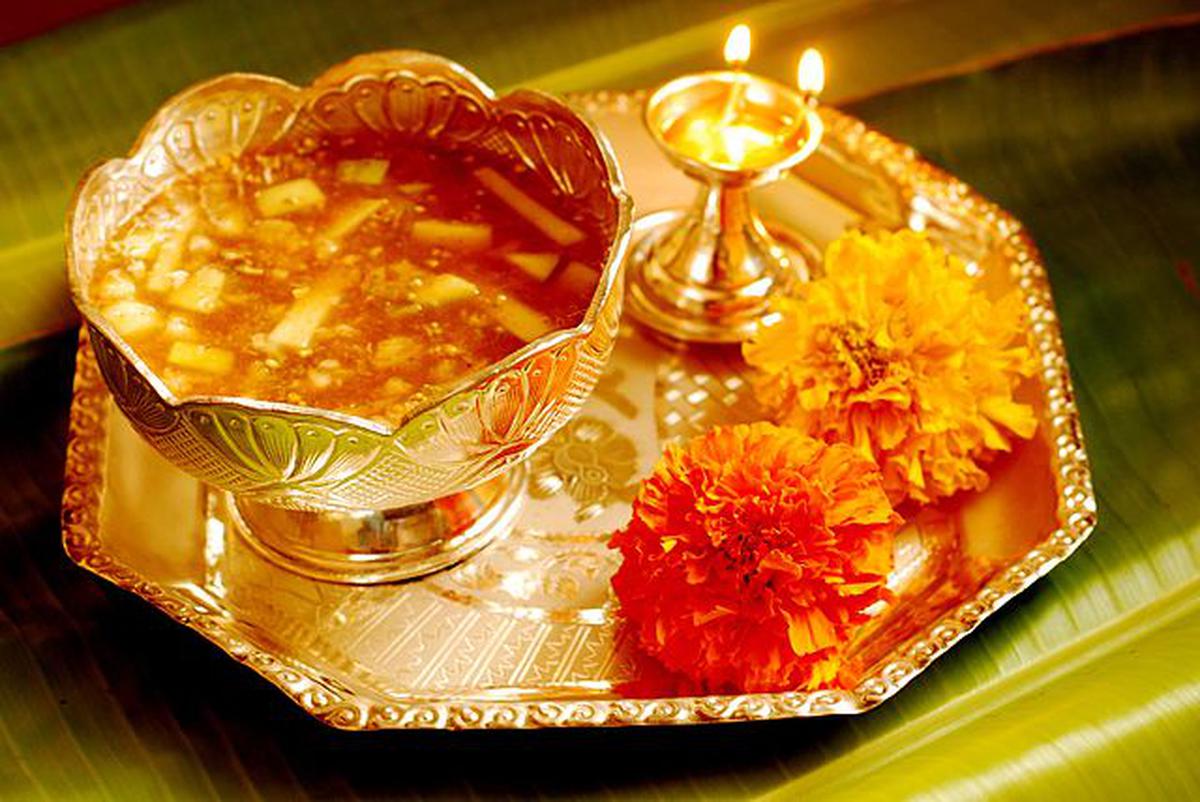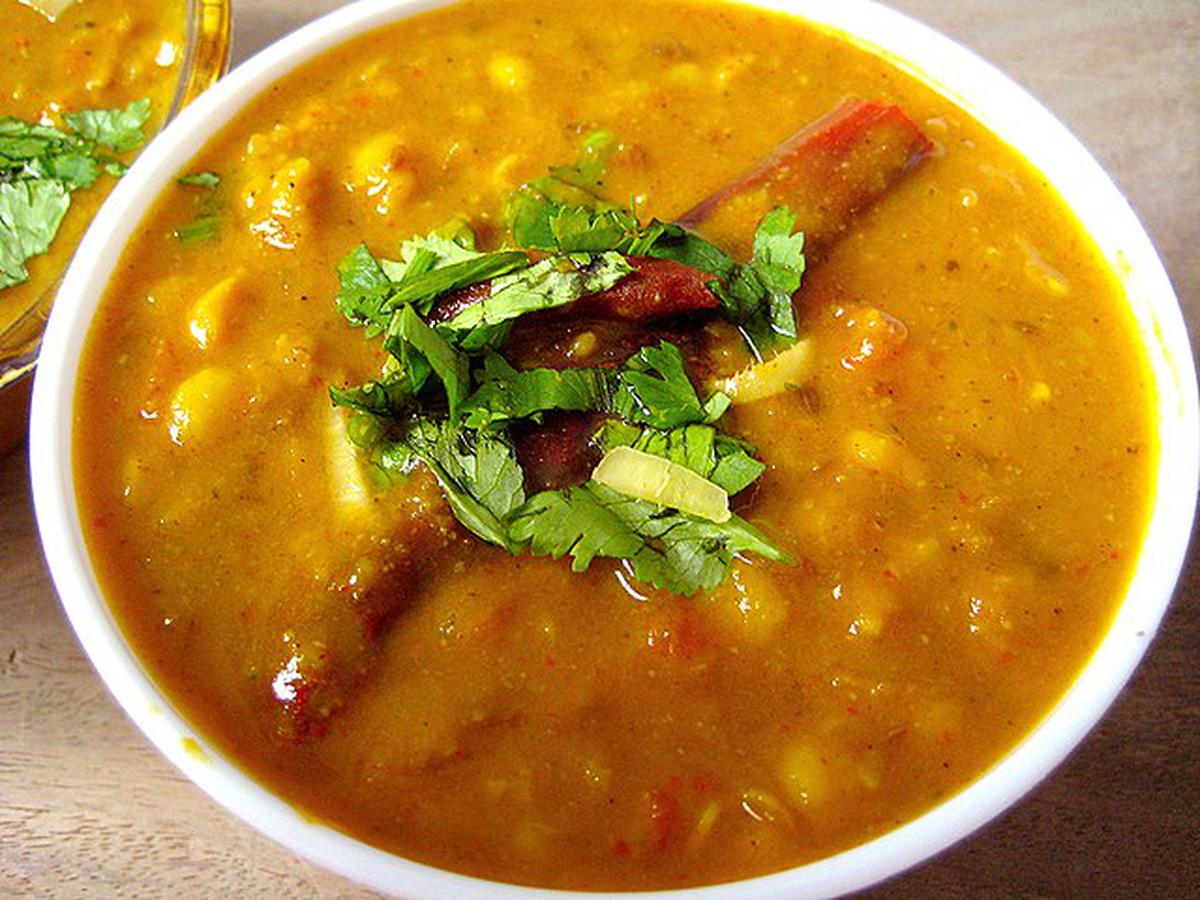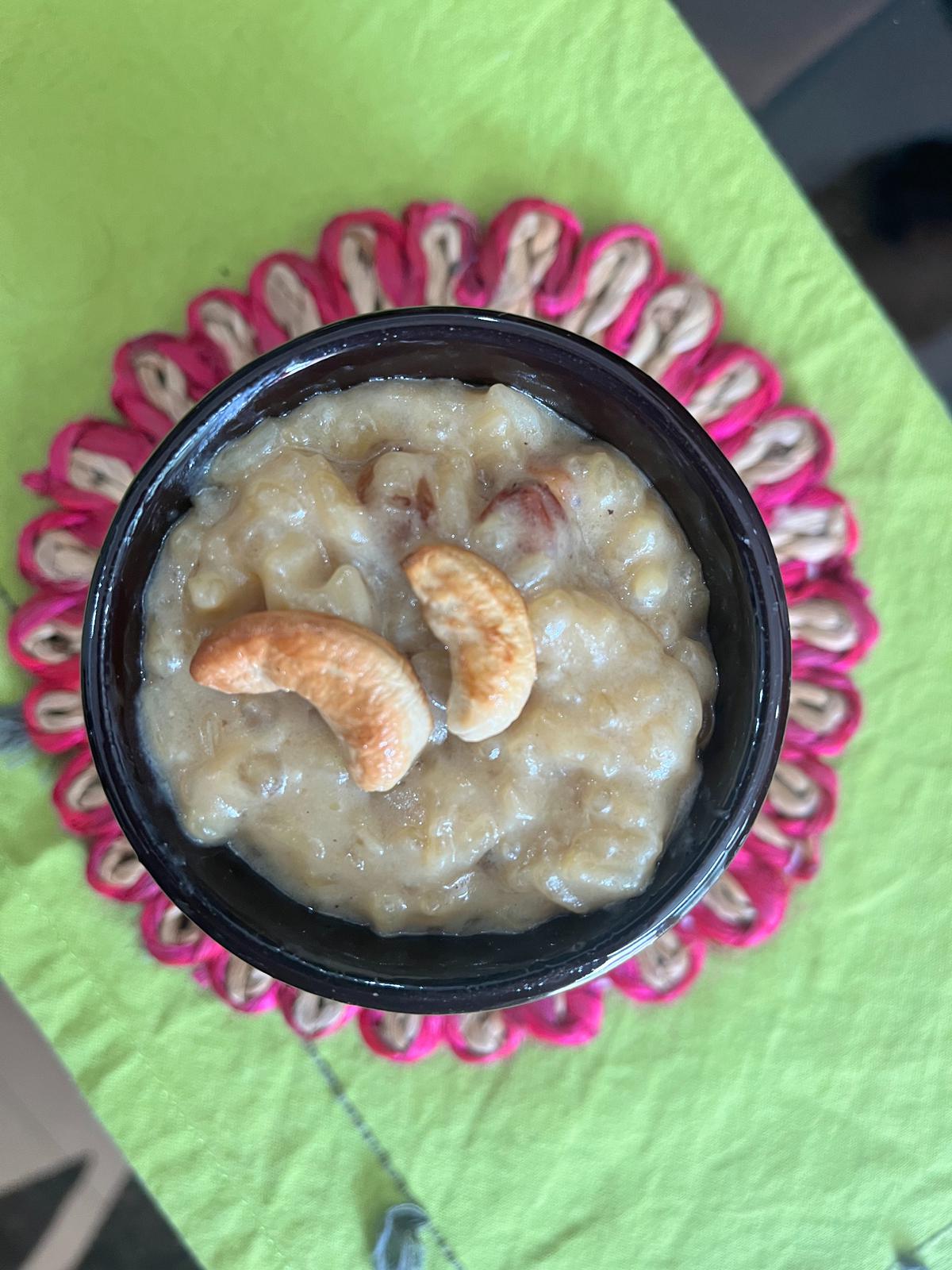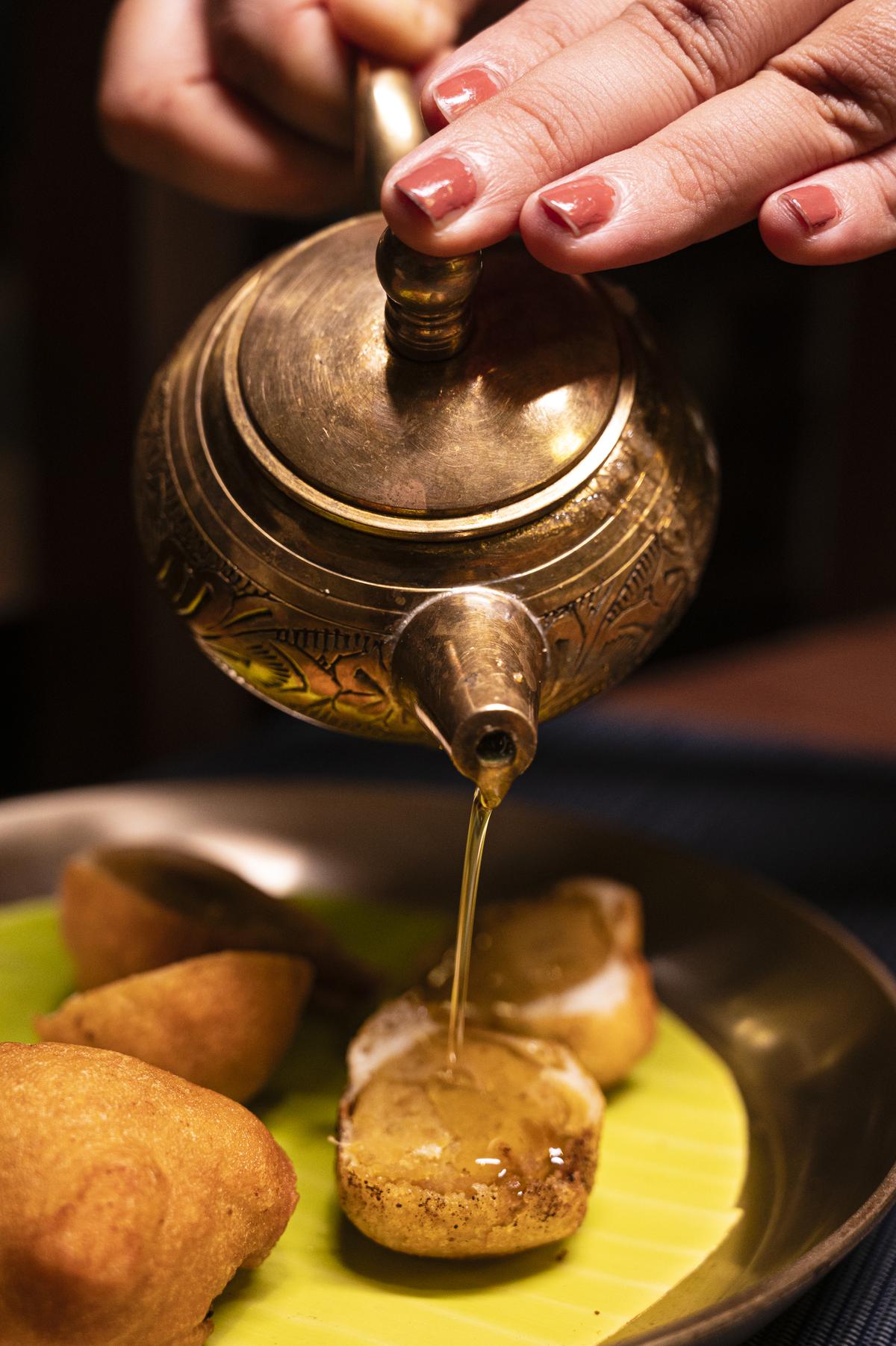Ugadi Pachadi prepared on the occasion of Shobhakritu Naam Samvatsar Ugadi. Photo credits: G. Ramakrishna
ugadi pachadi

ugadi pachadi
Serves – 4 portions
Component
-
Powdered jaggery – ½ cup
-
Tamarind pulp – ½ cup
-
Raw mango chopped – ½ cup
-
Neem flowers – 1 tsp
-
Grated fresh coconut – 1 tsp
-
Bengal gram (soaked overnight) – 1 tbsp
-
Ripe Banana, chopped – 2 tbsp
-
salt to taste
-
Chili powder – ¼ tsp
Process
-
Soak tamarind in hot water for half an hour, filter and take out its pulp in a bowl.
-
Add powdered jaggery to the tamarind pulp and mix till it dissolves.
-
add soaked chana dal to the mixture
-
Add neem flowers, fresh coconut, ripe banana, salt, chili powder, small pieces of raw mango
Mamidikaya Pappu (Raw Mango Lentils)

mamidikaya pappu
Serves – 4 portions
Component
-
Toor Dal – 1 cup
-
Raw mango (sour variety) – ¾ cup
-
Green chili – 06 big
-
Curry leaves – 2 tbsp
-
Asafoetida – 1 tsp
-
Red chili – 3 nos
-
Water – 4 cups
-
Cumin – 1 tbsp
-
Mustard seeds – 1 tbsp
-
Garlic – 1 tbsp minced
-
Refined vegetable oil – 4 tbsp
-
salt to taste
Preparation
-
Wash toor dal and take it out in the cooker, add water, raw mango pieces, green chillies, curry leaves and salt. Cook on medium heat for four whistles and keep aside.
-
For tempering, heat vegetable oil in a pan and add mustard seeds and after crackling add red chillies, asafoetida, cumin seeds and peeled garlic.
-
Add tadka to the cooked dal and adjust the consistency of dal with salt and water as per taste.
-
serve hot
Note: It is important to check the sourness of the mangoes used and adjust the quantity for the final taste of the dal
Recipe by Chef Thimma Reddy, Executive Chef, The Park, Hyderabad
Belam Payasam/Pongal

Belam Pongal
Serving Size: 4 Portions
Component
-
Full cream milk (non-boiled) – 1 cup
-
Rice – 1/4 cup
-
Sabudana – 1/4 cup
-
Jaggery, cut into small pieces – 1/2 cup
-
Water – 1/4 cup + 1/4 cup
-
Cashew nuts, chopped – 3-4 tbsp
-
Raisins – 3-4 tbsp
-
Ghee – 2 tbsp
-
Cardamom powder – 1/2 tsp
Preparation
-
Wash rice and sago separately and soak them for 15-20 minutes, then drain the water and keep them aside.
-
Pour milk in a heavy bottom vessel and let it boil on low flame.
-
Add soaked rice and sago in boiled milk.
-
Cook on low flame and keep stirring in between.
-
After cooking for 10 minutes, add 1/4 cup of water so that rice and sago do not stick to the bottom of the pan.
-
After about 15 minutes of cooking, the rice-sago is fully cooked and the whole mixture gets a nice creamy texture.
-
Add 1/2 tsp cardamom powder and mix well.
-
Switch off the flame and keep the mixture aside to cool slightly.
-
Take 1/4 cup water and 1/2 cup jaggery in a bowl. Cook on low heat till the jaggery melts completely. Switch off the flame and let it cool down a bit.
-
Fry cashews and raisins in 2 tbsp ghee till they turn golden brown.
-
Strain the jaggery syrup and put it in the cream milk mixture. mix well.
-
Put fried cashews and raisins along with ghee in the above mixture. mix well.
-
Tastes best both as a nice hot pudding or chilled.
Note: The creamy milk mixture and jaggery syrup should not be hot while mixing together, else the milk will curdle.
Recipe by home cook Swati Chavalam
Mamidikaya Pulihora (Raw Mango Pulihora)

Mamidikaya Pulihora
Servings: 6 Portions
Component
-
Raw mango (grated) – 2 nos (small)
-
Rice (boiled) – 2 cups
-
Mustard seeds – 1/2 tsp
-
Cumin – 1/2 tsp
-
Asafoetida – a pinch
-
Red chili (dry) – 3
-
Cashew – 1/4 cup
-
Bengal gram – 1 tbsp
-
Urad Dal – 1 tbsp
-
Turmeric – 1/4 tsp
-
Curry leaves – 2 sprigs
-
Coriander leaves (chopped) – 1 bunch
-
Green chili (chopped) – 6
-
Oil – 2 tbsp
-
salt to taste
Preparation
-
Heat a pan, add oil to it.
-
Add mustard seeds, cumin seeds, red chillies, cashews, chana dal and urad dal to the hot oil.
-
Fry them until the color of urad dal turns light brown.
-
Add asafoetida, turmeric and fry.
-
Add green chilies, curry leaves, grated raw mango, salt to the mixture and let it cook for a few minutes.
-
Add boiled rice to it, sprinkle coriander leaves over it and toss for two to three minutes.
-
Finally adjust the seasoning and serve hot.
Recipe by Chef Sanjay Thumma, Wah Re Wah
Poornalu

Poornalu | Photo credit: Johan Satyadas, The Hindu
Serv – 15 – 20 numbers
Component
-
Urad Dal – 1/2 cup
-
Rice (uncooked) – 3/4 cup
-
all purpose flour
-
Chana dal – 1 cup
-
Ghee
-
Black cardamom powder – 1/2 tsp
-
Grated Coconut – 1 1/2 tbsp
-
water (3 cups
-
Jaggery – 1/2 cup
-
Refined oil for frying
-
salt to taste
Preparation
for batter
-
Soak rice and urad dal in water overnight.
-
After soaking, wash it 2 times and add some water and grind it in a mixer to make a smooth solution.
-
Add flour to make consistency and mix well.
Bengal gram for the mixture
-
Wash the gram dal thoroughly.
-
In a large bottomed pan, add chana dal, add water and bring to a boil.
-
Pressure cook till the chana dal becomes soft and drain the water.
for full
-
Add grated jaggery in a pan.
-
Mix it till the jaggery melts and add chana dal and coconut. Keep stirring till the consistency becomes a thick paste and can be formed into a ball.
-
Add cardamom powder and ghee to the mixture, mix well and let it cool.
-
Roll the chana dal mixture into lemon sized balls and keep aside
-
In a pan, add oil for frying the purnalu. Check whether the oil is hot enough for frying by adding a drop of urad dal batter.
-
Mix the urad dal batter well and dip the chana balls into the mixture, making sure they are completely coated.
-
Drop them in hot oil and fry the balls on medium heat till they turn golden brown.
-
Take out the fried poornalu in a plate.
-
While serving, make a small hole in the purnalu and pour a spoonful of ghee into it.
Recipe by Vivah Bhojanambu chain of restaurants